The Santa Ana PD patrol car slowly cruised down a residential street in the heart of one of the city’s oldest and most notorious street gang’s territory, bordered by 17th Street on the north, Bristol Street on the east, 1st Street on the south, and Fairview Street on the west.
Det. Peter Beaumarchais recognized a gang member rolling by on a bicycle and shouted out his driver’s window:
“Johnny, what’s up, man?”
The man gave a subtle motion of his head but kept quiet — and kept moving.
On Jan. 6, 2020, the Santa Ana PD, flush with a 20-year high of 50 new police officers hired in 12 months last year, rolled out a new unit called the Major Enforcement Team (MET).
The full-time MET, with a sergeant and seven officers, proactively roams the city’s street to suppress violent crime, with the training and tools to be quickly deployed to hot spots.
The MET is a new, improved spin on the SAPD’s former Strike Force, a full-time SWAT unit that ran from 2005 to 2013. The MET was created as a result of the SAPD’s 2019-2024 Strategic Plan, whose bedrock is community-based policing.
“One of the priorities we identified was to establish a proactive enforcement team of some type,” SAPD Chief David Valentin said. “Last year, we had a very successful hiring cycle of 50 police officers. Because of that, we’re able to now go back and look at staffing various priorities – and this is one of them.”
Sitting in the passenger seat on a recent late afternoon next to Beaumarchais was Sgt. Oscar Lizardi, the team leader of MET and an original member of the Strike Force. He said in January 2020 alone, the MET made 75 arrests – half of the people with a history of violent felonies, including attempted murder. The team also seized four guns.
“We go after the city’s most wanted,” said Lizardi, a 21-year veteran of the SAPD. “I couldn’t be happier with the productivity and work ethic and attitude of our team.”
Beaumarchais and Lizardi, with their colleagues in other units, patrolled some gang-infested neighborhoods after a busy early afternoon. Around noon that day, the MET led a search warrant operation at a home that yielded the seizure of narcotics and netted several arrests.
After lunch at Chipotle, the MET rolled out to patrol the streets.
Later that evening, back at SAPD headquarters, the team planned for a big event the following day – a public speech by a presidential candidate. In addition to suppressing violent crime, the MET serves as the SAPD’s primary response team for major incidents and events.
“Ultimately,” Lizardi said, “what we want to do is make the community safer.”
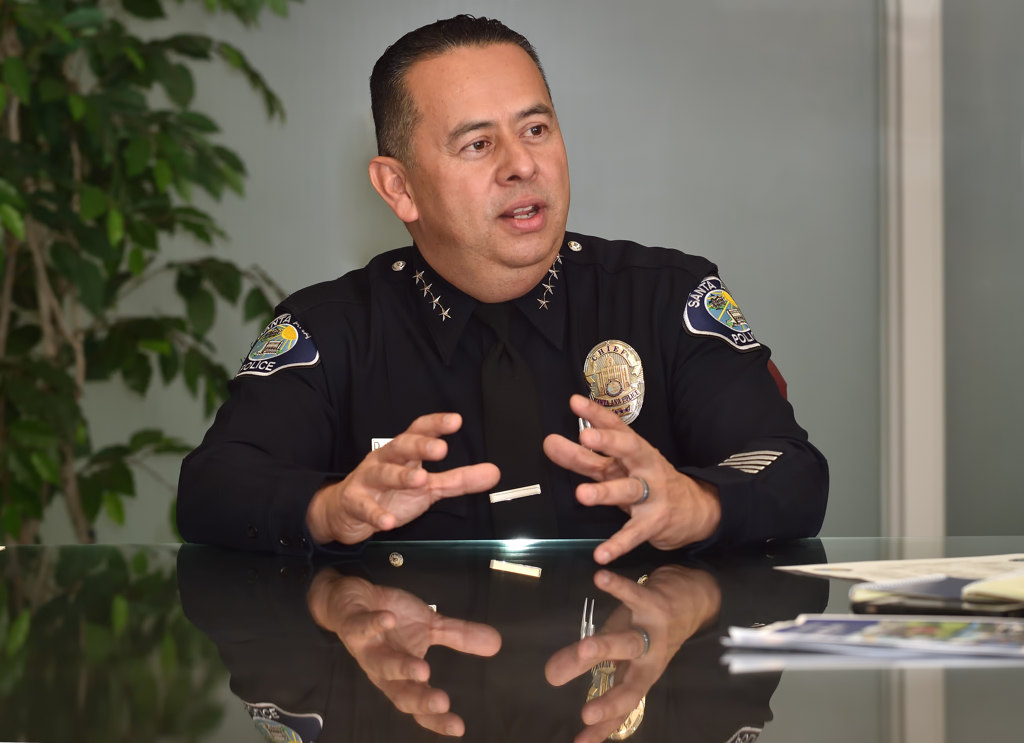
Santa Ana Police Chief David Valentin talks about the creation of the new MET (Major Enforcement Team) that is part of the SAPD’S Metropolitan Division.
Photo by Steven Georges/Behind the Badge
NEW STRUCTURE
The MET is part of the SAPD’s newly formed Metropolitan Division, led by Commander Phil Craft. The Metropolitan Division also includes the SAPD’s full-time Gang Unit as well as members of Special Weapons and Tactics (SWAT), an ancillary duty. The Metropolitan Division falls under the Investigation Bureau, headed by Deputy Chief Ken Gominsky.
Valentin, who is approaching his 30th anniversary at SAPD, said one of the lessons learned from the Strike Force was that unit wasn’t in the same unity of command.
“They essentially had two bosses,” Valentin explained. “From an operational standpoint, they reported to one chain of command, and then from a SWAT element they reported to another.
“So fast forward, in support of our new strategic plan that we put together after receiving input from the community, city leaders, and department personnel, we decided to join both the Gang Unit and the MET team under one division, and SWAT as well. Now, there’s a clear line of command and mission clarity.”
The MET responds to various crime issues in Santa Ana.
“It could be a violent crime; it could be narcotics, it could be gangs, gun trafficking – that’s a focus of the team, to seize guns from the streets,” Valentin said.
“The idea is to either address a crime in progress or prevent a future crime. For example, one day last week, we had a complaint in a gang neighborhood, and we knew that there was a rival gang driving around circling that neighborhood and likely up to no good.
“And so MET deployed and stayed consistent in their patrols and eventually stopped and arrested an armed gang member from that opposing neighborhood gang.

An SAPD MET officer questions a detainee during a traffic stop earlier this month. Photo by Steven Georges/Behind the Badge
“Can I definitively say 100 percent that a crime was prevented? No, but arresting a documented gang member on parole with a loaded weapon in an adjacent gang territory – that’s not a good combination.”
The SAPD currently is authorized for 384 officers and has close to 350 now working. Valentin said he plans to have up to 384 officers hired by the end of 2020 – the result of a beefed-up recruitment effort that goes beyond traditional strategies such as setting up booths at colleges.
“We dedicated a full-time officer to recruitment last year, and we put together a strategic plan to recruit in non-traditional ways,” Valentin said. “For example, we had officers at every football game at Santa Ana College last year.”
Some of the 50 SAPD officers hired in 2019 are addressing quality-of-life issues such as the homelessness crisis, Valentin said. And what is the SAPD’s message to potential recruits?

Santa Ana PD officers who are on the MET gather in a parking lot near a business housing an Illegal gambling operation.
Photo by Steven Georges/Behind the Badge
“We approach policing from a genuine appreciation standpoint,” Valentin said. “We’re looking for officers who understand the challenges that we have here in our city and knowing that they come here because they have it in their hearts and their minds to make a difference.
“We understand our community, and we actively promote engagement at every level.”
RIGOROUS SELECTION PROCESS
Lizardi said about a couple dozen officers applied to the MET, and choosing the seven currently on the team was very difficult.
“The (ones that made it) were known for proactive enforcement and being diligent in addressing community concerns, particularly gang complaints, violent crime, robberies, and carjackings,” Valentin said.
In addition to Lizardi and Beaumarchais, the members of MET are Cpl. Travis Johnson, Detective John Rodriguez (an original Strike Force member), Detective Patrick Marshall, Detective Jonathan Pérez, Detective Eric Sanchez, and Detective Jonathan McKee. Lizardi, Johnson, Marshall, McKee, and Sanchez also are on the SAPD’s SWAT unit.
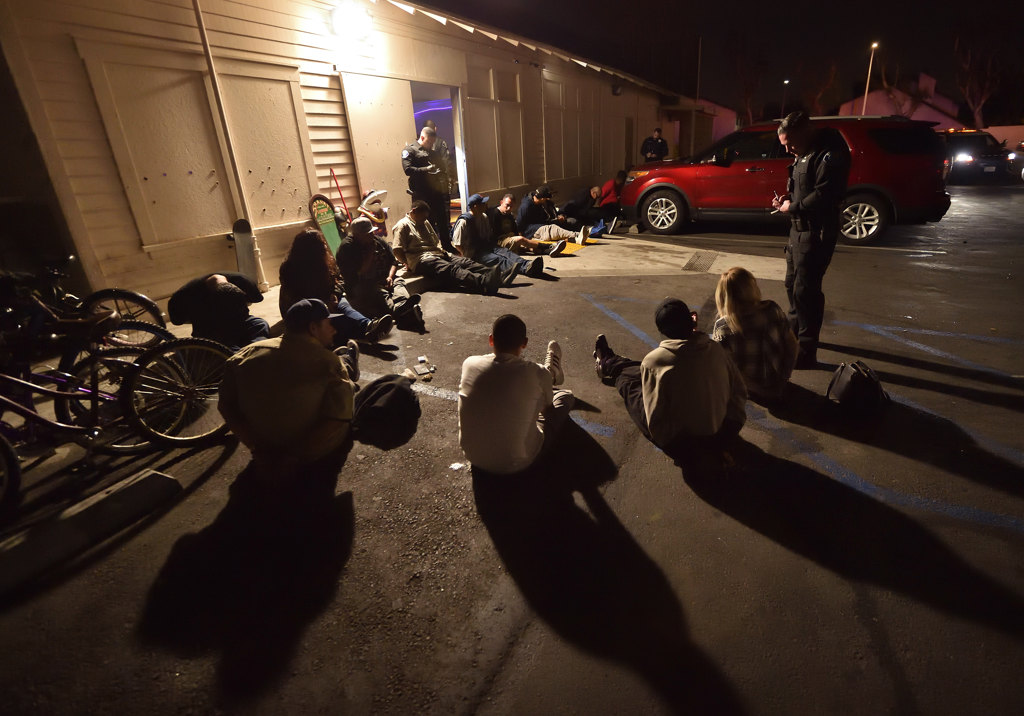
MET members question patrons of an Illegal gambling business in Santa Ana sit outside as they search inside the “slap house.”
Photo by Steven Georges/Behind the Badge
Beaumarchais began his career at the SAPD in 2013 and came to the MET from the Gang Unit.
“A normal patrol officer is going to be doing this (proactive enforcement) as much as he or she can in between calls,” he said. “Our priority is to suppress violent crime in the city. Patrol offices have to wear a lot of different hats.”
Indeed, the MET frees up regular patrol officers to spend more time responding to calls for service as well as engaging with members of the community.
“This initiative directly supports our Community Oriented Policing Philosophy,” Valentin said. “I encourage officers to get out of their car and have conversations with community members – really, about anything. So that’s the beauty of (the MET) as well.”
Beaumarchais was on the Gang Unit for almost three years; his brother, Greg, still is on it.
“For me, I like the fast tempo, going out there and going after the upper-echelon type of criminals,” Beaumarchais said of the appeal of being on the MET. “In gangs, we did that continuously. I would say roughly 90 percent of all violent crimes in Santa Ana are gang-related.
“I knew that with my experience as a gang investigator, I could come over here and be an asset to this team.”
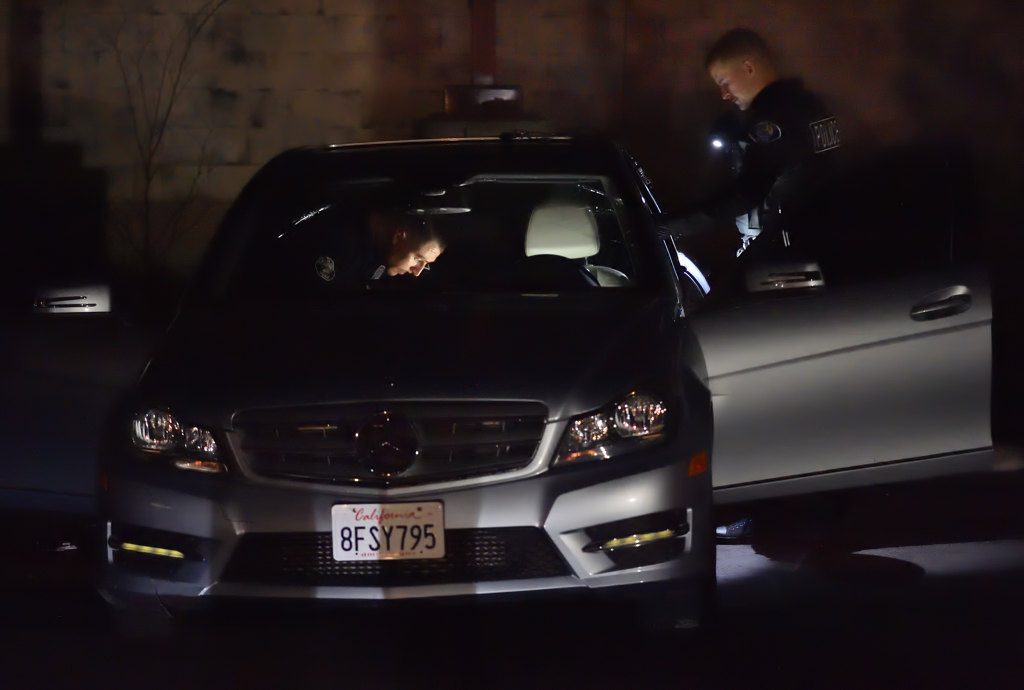
MET officers search a Mercedes Bens belonging to a customer of an Illegal gambling business in Santa Ana.
Photo by Steven Georges/Behind the Badge
In just a few months, the presence of the MET, in addition to other SAPD efforts, has reduced the number of gangs in the city to well below 100, from more than 100, Lizardi and Beaumarchais said.
They pull into a neighborhood, where in the driveway of a house on a corner more than a half dozen men are gathered. The men stare at the patrol unit.
“Gangsters,” Beaumarchais said.
Lizardi said just the presence of the MET patrols helps.
“Just seeing cops helps suppress crime,” he said.
The MET officers look for people on parole, on drugs, or drinking in public. They scan neighborhoods for new graffiti that indicates gang activity.
“When it comes down to overall crime reduction, we have to stay on top of where it’s occurring and who’s involved,” Lizardi said. “A lot of what we do is derived based on our intelligence that we get from being out in the field, and our prior knowledge. We have to be able to look at some of the graffiti and start connecting the dots as to why this particular gang is over here. There’s a lot to the puzzle.”
He added: “They (criminal element) are watching us just as well as we’re watching them. And they’re good at what they do, which sometimes can become challenging.”
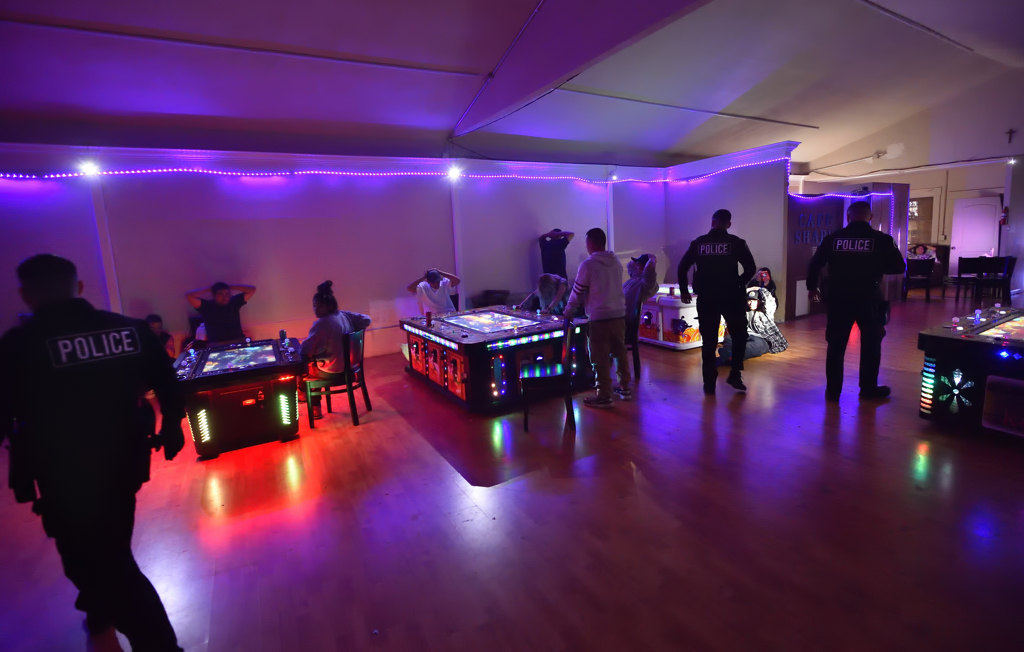
Customers keep their hands above their heads as MET officers search an Illegal “slap house” gambling business in Santa Ana.
Photo by Steven Georges/Behind the Badge
Beaumarchais drove past El Salvador Park, a hub of illegal activity.
“Mexican Mafia gang members used to hold meetings in the park,” Lizardi said. “We’ve had a lot of foot pursuits here, a lot of arrests, and some officer-involved shootings.”
Just after 6 p.m., the MET stopped a suspicious car. One of the officers saw a man in the back flashing gang signs outside his window.
“We’re just travelers,” the driver told the officers.
A female in the passenger seat in the black Saturn got verbally aggressive. After several minutes, the officers let the trio leave but told them to stay out of the city.
Lizardi said he’s confident the woman was a prostitute, and the driver, a man from Pennsylvania with an outstanding warrant from that state, was her pimp. They were spotted in an area known for prostitution near Harbor Boulevard and Hazard Avenue
Gang members will allow outside prostitutes to conduct business on their turf in exchange for a small share of their earnings, Lizardi explained.
The MET team early that evening also raided a “slap house” – an illegal gambling spot named after the slapping sound of people hitting buttons on an arcade game.
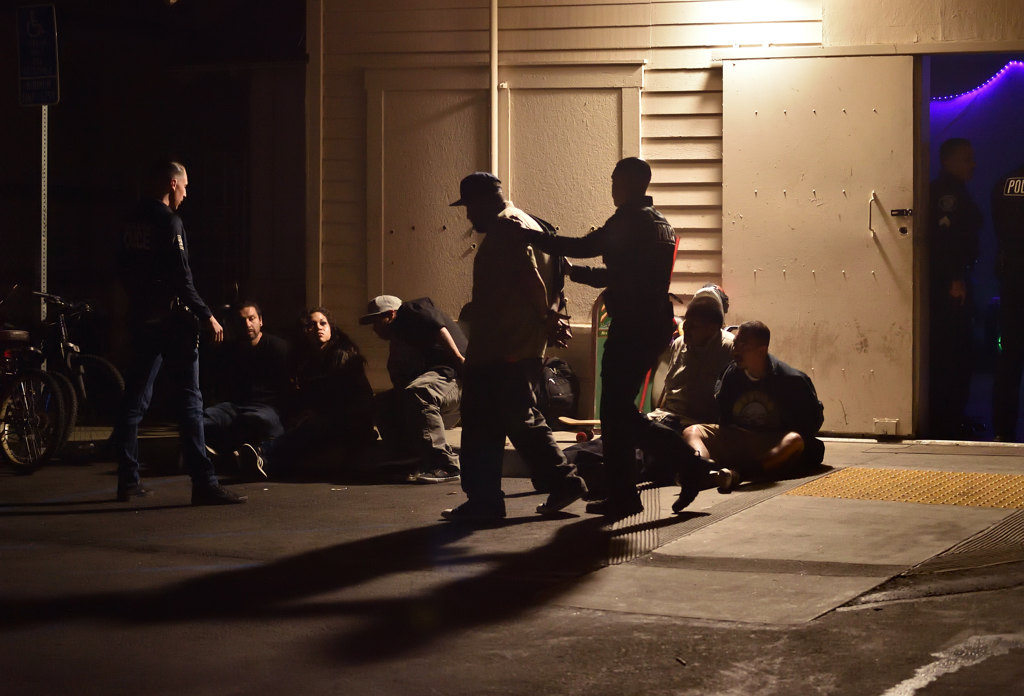
Santa Ana PD MET officers line up customers outside an Illegal gambling business as they question some of them.
Photo by Steven Georges/Behind the Badge
Slap houses are a growing problem in Santa Ana, and a magnet for drug users and other criminal activity, Lizardi said. They often operate out of what look like vacant storefronts, but they also operate out of homes.
This particular slap house operated out of a business. The MET officers detained about 40 people who were gambling in a low-lit, smoke-choked room with purple neon lighting. Several of the gamblers appeared to be under the influence of drugs, including a blonde woman from Newport Beach who drives a silver Mercedes.
The woman is on probation for narcotics sales. She gave consent to the MET officers to search her car. It was clean.
The MET officers collected personal information from the gamblers as they all sat outside in the parking lot with their legs straight out and their hands behind their backs.
“Some of these individuals are parolees, and some may be parolees at large,” Lizardi said. “Some may be career criminals and gangsters. We develop intelligence. We find out who’s who, why they’re here, who they’re meeting up with, and we forward that information to vice and other units.”
Lizardi and his team officially works four 10-hour shifts per week, but in reality, their schedule is all over the map – and often late into the wee hours of the morning, including weekends.
“I have 23 years on the job,” Lizardi said. “I don’t have to work weekends if I don’t want to, but I choose to because I know we’re making a difference.”
Lizardi said the vast majority of Santa Ana residents are very supportive of the MET and all SAPD officers.

Santa Ana PD MET Officer Jonathan McKee searches a customer who was inside an Illegal gambling business in Santa Ana.
Photo by Steven Georges/Behind the Badge
“And really that’s what keeps us motivated,” Lizardi said. “We know that when we drive through gang-infested communities and high-crime drug areas, the majority of the residents are actually people that are afraid of the bad guys and don’t have another option but to live there.
“It’s important for us to do our very best to keep them safe. That’s what fuels us.”
 Behind the Badge
Behind the Badge




